[English] 日本語
 Yorodumi
Yorodumi- EMDB-22421: ORC-DNA: Human Origin Recognition Complex (ORC) with DNA bound in... -
+ Open data
Open data
- Basic information
Basic information
| Entry | Database: EMDB / ID: EMD-22421 | ||||||||||||
|---|---|---|---|---|---|---|---|---|---|---|---|---|---|
| Title | ORC-DNA: Human Origin Recognition Complex (ORC) with DNA bound in the core | ||||||||||||
 Map data Map data | ORC-DNA: Human Origin Recognition Complex (ORC) with DNA bound in the core | ||||||||||||
 Sample Sample |
| ||||||||||||
 Keywords Keywords | replication / AAA+ / ORC / DNA-binding / cryoEM / replication-DNA complex | ||||||||||||
| Function / homology |  Function and homology information Function and homology informationpolar body extrusion after meiotic divisions / CDC6 association with the ORC:origin complex / origin recognition complex / E2F-enabled inhibition of pre-replication complex formation / nuclear origin of replication recognition complex / nuclear pre-replicative complex / inner kinetochore / DNA replication preinitiation complex / mitotic DNA replication checkpoint signaling / neural precursor cell proliferation ...polar body extrusion after meiotic divisions / CDC6 association with the ORC:origin complex / origin recognition complex / E2F-enabled inhibition of pre-replication complex formation / nuclear origin of replication recognition complex / nuclear pre-replicative complex / inner kinetochore / DNA replication preinitiation complex / mitotic DNA replication checkpoint signaling / neural precursor cell proliferation / G1/S-Specific Transcription / regulation of DNA replication / DNA replication origin binding / protein polymerization / DNA replication initiation / Activation of the pre-replicative complex / Activation of ATR in response to replication stress / glial cell proliferation / heterochromatin / Assembly of the ORC complex at the origin of replication / Assembly of the pre-replicative complex / Orc1 removal from chromatin / DNA replication / chromosome, telomeric region / nuclear body / nucleotide binding / chromatin binding / centrosome / chromatin / nucleolus / negative regulation of transcription by RNA polymerase II / ATP hydrolysis activity / DNA binding / nucleoplasm / ATP binding / metal ion binding / nucleus / membrane / cytosol Similarity search - Function | ||||||||||||
| Biological species |  Homo sapiens (human) / Homo sapiens (human) /  | ||||||||||||
| Method | single particle reconstruction / cryo EM / Resolution: 4.4 Å | ||||||||||||
 Authors Authors | Jaremko MJ / Joshua-Tor L | ||||||||||||
| Funding support |  United States, 3 items United States, 3 items
| ||||||||||||
 Citation Citation |  Journal: Elife / Year: 2020 Journal: Elife / Year: 2020Title: The dynamic nature of the human origin recognition complex revealed through five cryoEM structures. Authors: Matt J Jaremko / Kin Fan On / Dennis R Thomas / Bruce Stillman / Leemor Joshua-Tor /  Abstract: Genome replication is initiated from specific origin sites established by dynamic events. The Origin Recognition Complex (ORC) is necessary for orchestrating the initiation process by binding to ...Genome replication is initiated from specific origin sites established by dynamic events. The Origin Recognition Complex (ORC) is necessary for orchestrating the initiation process by binding to origin DNA, recruiting CDC6, and assembling the MCM replicative helicase on DNA. Here we report five cryoEM structures of the human ORC (HsORC) that illustrate the native flexibility of the complex. The absence of ORC1 revealed a compact, stable complex of ORC2-5. Introduction of ORC1 opens the complex into several dynamic conformations. Two structures revealed dynamic movements of the ORC1 AAA+ and ORC2 winged-helix domains that likely impact DNA incorporation into the ORC core. Additional twist and pinch motions were observed in an open ORC conformation revealing a hinge at the ORC5·ORC3 interface that may facilitate ORC binding to DNA. Finally, a structure of ORC was determined with endogenous DNA bound in the core revealing important differences between human and yeast origin recognition. | ||||||||||||
| History |
|
- Structure visualization
Structure visualization
| Movie |
 Movie viewer Movie viewer |
|---|---|
| Structure viewer | EM map:  SurfView SurfView Molmil Molmil Jmol/JSmol Jmol/JSmol |
| Supplemental images |
- Downloads & links
Downloads & links
-EMDB archive
| Map data |  emd_22421.map.gz emd_22421.map.gz | 98.3 MB |  EMDB map data format EMDB map data format | |
|---|---|---|---|---|
| Header (meta data) |  emd-22421-v30.xml emd-22421-v30.xml emd-22421.xml emd-22421.xml | 24.5 KB 24.5 KB | Display Display |  EMDB header EMDB header |
| Images |  emd_22421.png emd_22421.png | 146.1 KB | ||
| Filedesc metadata |  emd-22421.cif.gz emd-22421.cif.gz | 8.3 KB | ||
| Archive directory |  http://ftp.pdbj.org/pub/emdb/structures/EMD-22421 http://ftp.pdbj.org/pub/emdb/structures/EMD-22421 ftp://ftp.pdbj.org/pub/emdb/structures/EMD-22421 ftp://ftp.pdbj.org/pub/emdb/structures/EMD-22421 | HTTPS FTP |
-Validation report
| Summary document |  emd_22421_validation.pdf.gz emd_22421_validation.pdf.gz | 503.1 KB | Display |  EMDB validaton report EMDB validaton report |
|---|---|---|---|---|
| Full document |  emd_22421_full_validation.pdf.gz emd_22421_full_validation.pdf.gz | 502.7 KB | Display | |
| Data in XML |  emd_22421_validation.xml.gz emd_22421_validation.xml.gz | 6.6 KB | Display | |
| Data in CIF |  emd_22421_validation.cif.gz emd_22421_validation.cif.gz | 7.4 KB | Display | |
| Arichive directory |  https://ftp.pdbj.org/pub/emdb/validation_reports/EMD-22421 https://ftp.pdbj.org/pub/emdb/validation_reports/EMD-22421 ftp://ftp.pdbj.org/pub/emdb/validation_reports/EMD-22421 ftp://ftp.pdbj.org/pub/emdb/validation_reports/EMD-22421 | HTTPS FTP |
-Related structure data
| Related structure data |  7jpsMC  7jpoC  7jppC  7jpqC  7jprC M: atomic model generated by this map C: citing same article ( |
|---|---|
| Similar structure data |
- Links
Links
| EMDB pages |  EMDB (EBI/PDBe) / EMDB (EBI/PDBe) /  EMDataResource EMDataResource |
|---|---|
| Related items in Molecule of the Month |
- Map
Map
| File |  Download / File: emd_22421.map.gz / Format: CCP4 / Size: 125 MB / Type: IMAGE STORED AS FLOATING POINT NUMBER (4 BYTES) Download / File: emd_22421.map.gz / Format: CCP4 / Size: 125 MB / Type: IMAGE STORED AS FLOATING POINT NUMBER (4 BYTES) | ||||||||||||||||||||||||||||||||||||||||||||||||||||||||||||||||||||
|---|---|---|---|---|---|---|---|---|---|---|---|---|---|---|---|---|---|---|---|---|---|---|---|---|---|---|---|---|---|---|---|---|---|---|---|---|---|---|---|---|---|---|---|---|---|---|---|---|---|---|---|---|---|---|---|---|---|---|---|---|---|---|---|---|---|---|---|---|---|
| Annotation | ORC-DNA: Human Origin Recognition Complex (ORC) with DNA bound in the core | ||||||||||||||||||||||||||||||||||||||||||||||||||||||||||||||||||||
| Projections & slices | Image control
Images are generated by Spider. | ||||||||||||||||||||||||||||||||||||||||||||||||||||||||||||||||||||
| Voxel size | X=Y=Z: 1.07 Å | ||||||||||||||||||||||||||||||||||||||||||||||||||||||||||||||||||||
| Density |
| ||||||||||||||||||||||||||||||||||||||||||||||||||||||||||||||||||||
| Symmetry | Space group: 1 | ||||||||||||||||||||||||||||||||||||||||||||||||||||||||||||||||||||
| Details | EMDB XML:
CCP4 map header:
| ||||||||||||||||||||||||||||||||||||||||||||||||||||||||||||||||||||
-Supplemental data
- Sample components
Sample components
+Entire : ORC-DNA
+Supramolecule #1: ORC-DNA
+Macromolecule #1: Origin recognition complex subunit 1
+Macromolecule #2: Origin recognition complex subunit 2
+Macromolecule #3: Origin recognition complex subunit 3
+Macromolecule #4: Origin recognition complex subunit 4
+Macromolecule #5: Origin recognition complex subunit 5
+Macromolecule #6: DNA (5'-D(*AP*TP*AP*TP*AP*TP*AP*TP*AP*TP*AP*AP*T)-3')
+Macromolecule #7: DNA (5'-D(*AP*TP*TP*AP*TP*AP*TP*AP*TP*AP*TP*AP*T)-3')
+Macromolecule #8: ADENOSINE-5'-TRIPHOSPHATE
+Macromolecule #9: MAGNESIUM ION
+Macromolecule #10: POTASSIUM ION
-Experimental details
-Structure determination
| Method | cryo EM |
|---|---|
 Processing Processing | single particle reconstruction |
| Aggregation state | particle |
- Sample preparation
Sample preparation
| Concentration | 0.8 mg/mL | ||||||||||||||||||
|---|---|---|---|---|---|---|---|---|---|---|---|---|---|---|---|---|---|---|---|
| Buffer | pH: 7.5 Component:
| ||||||||||||||||||
| Grid | Model: Quantifoil R2/2 / Material: COPPER / Mesh: 300 / Pretreatment - Type: GLOW DISCHARGE | ||||||||||||||||||
| Vitrification | Cryogen name: ETHANE / Instrument: LEICA EM GP |
- Electron microscopy
Electron microscopy
| Microscope | TFS KRIOS |
|---|---|
| Image recording | Film or detector model: GATAN K2 SUMMIT (4k x 4k) / Detector mode: COUNTING / Number grids imaged: 1 / Number real images: 9068 / Average exposure time: 6.0 sec. / Average electron dose: 66.0 e/Å2 |
| Electron beam | Acceleration voltage: 300 kV / Electron source:  FIELD EMISSION GUN FIELD EMISSION GUN |
| Electron optics | C2 aperture diameter: 100.0 µm / Calibrated defocus max: 2.4 µm / Calibrated defocus min: 1.0 µm / Illumination mode: FLOOD BEAM / Imaging mode: BRIGHT FIELD / Cs: 2.7 mm |
| Experimental equipment |  Model: Titan Krios / Image courtesy: FEI Company |
+ Image processing
Image processing
-Atomic model buiding 1
| Initial model |
| ||||||||||||
|---|---|---|---|---|---|---|---|---|---|---|---|---|---|
| Refinement | Space: REAL / Protocol: RIGID BODY FIT / Overall B value: 231 / Target criteria: Correlation Coefficient | ||||||||||||
| Output model |  PDB-7jps: |
-Atomic model buiding 2
| Refinement | Space: REAL / Protocol: BACKBONE TRACE |
|---|---|
| Output model |  PDB-7jps: |
 Movie
Movie Controller
Controller








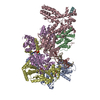

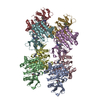
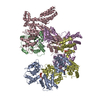
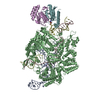
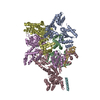






 Z (Sec.)
Z (Sec.) Y (Row.)
Y (Row.) X (Col.)
X (Col.)























